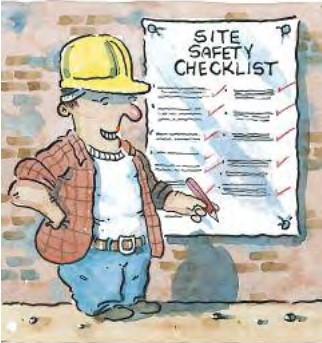Title Page
-
Site conducted
-
Conducted on
-
Prepared by
-
Location
Site Review
Site offices
-
Are site managers available
-
Is site Secure / Is the work fenced off from the public?
-
Are Site records accessible
-
Are the site information boards up to date
-
First aid kit and first aid staff named
-
Accident Book
-
Emergency alarm
-
Site welfare
Traffic/Pedestrian Control
-
Are pedestrians separated from traffic routes
-
Goods inward compound
-
Loads slung and secured correctly
-
Access angles /dangerous slopes
Excavations
-
Is there enough support for the excavation, or has it been<br>sloped or battered back to a safe angle?
-
Is a safe method used for putting in the support, without<br>people working in an unsupported trench?
-
Is there safe access into the excavation, eg a sufficiently<br>long, secured ladder?
-
Are there barriers or other protection to stop people and<br>vehicles falling in?
-
Are properly secured stop blocks provided to prevent tipping<br>vehicles falling in?
-
Could the excavation affect the stability of neighbouring<br>structures or services?
-
Are materials, spoil and plant stored away from the edge of<br>the excavation to reduce the chance of a collapse?
-
Is the excavation regularly inspected by a competent person?
Fire
-
Are suitable fire extinguishers provided?
-
Is the quantity of flammable materials, liquids and gases<br>kept to a minimum?
-
Are they properly stored?
-
Are flammable gas cylinders returned to a ventilated store at<br>the end of the shift?
-
When gas cylinders are not in use, are the valves fully<br>closed?
-
Are gas cylinders, associated hoses and equipment properly<br>maintained and in good condition?
-
Is flammable and combustible waste removed regularly and<br>stored in suitable bins or skips?
-
Are smoking and other ignition sources banned in areas<br>where gases or flammable liquids are stored or used?
Tools and machinery
-
Are the right tools or machinery being used for the job?
-
Are all dangerous parts guarded, eg gears, chain drives,<br>projecting engine shafts?
-
Are guards secured and in good repair?
-
Are tools and machinery maintained in good repair and are<br>all safety devices operating correctly?
-
Are all operators trained and competent?
Hazardous substances (COSHH) CIS26 / NDG304 /
-
Have workers had information and training so they know<br>what the risks are from the hazardous substances used and<br>produced on site, and what they need to do to avoid those<br>risks?
-
Have you got procedures to prevent contact with wet<br>cement (as this can cause dermatitis and cement burns)?
-
Have you arranged health surveillance for people using<br>certain hazardous substances (eg lead, silica, cement,<br>sensitisers such as two-pack adhesives or coatings)?
Noise INDG362
-
Have you identified and assessed workers’ exposure to<br>noise?
-
Have workers had information and training so they know<br>what the risks are from noise on site, and what they need to<br>do to avoid those risks?
-
Can the noise be reduced by using different working<br>methods or selecting quieter plant, eg by fitting breakers<br>and other plant or machinery with silencers?
-
Are people not involved in the work kept away from the<br>source of the noise?
-
Is suitable hearing protection provided and worn in noisy<br>areas?
-
Have hearing protection zones been marked?
-
Have you arranged health surveillance for people exposed to<br>high levels of noise?
Hand-arm vibration INDG175/ INDG296
-
Have you limited the time that each worker uses high-vibration tools such as concrete breakers, angle<br>grinders or hammer drills as far as possible?
-
Have workers had information and training so they know<br>what the risks are from handarm vibration (HAV) on site,<br>and what they need to do to avoid those risks?
-
Have vibrating tools been properly maintained including<br>keeping bits and drills sharp?
-
Have you arranged health surveillance for people exposed to<br>high levels of hand-arm vibration, especially when exposed<br>for long periods?
Electricity and other services
-
Are all connections to the system properly made and are<br>suitable plugs used?
-
Are you using low voltage for tools and equipment, eg<br>battery operated tools or low voltage systems?
-
Are cables and leads protected from damage?
-
Are tools and equipment checked by users, visually<br>examined on site and regularly inspected and tested by a<br>competent person?
-
Have hidden electricity cables and other services been<br>located (eg with a locator and plans) and marked, and have<br>you taken precautions for safe working?
-
Where there are overhead lines, has the electricity supply<br>been turned off, or have other precautions been taken, such<br>as providing ‘goal posts’ or taped markers?
-
Have all necessary services been provided on site before<br>work begins and have you also identified existing services<br>present on site (eg electric cables or gas mains) and taken<br>effective steps, if necessary, to prevent danger from them?
Site observations
-
general tidiness
-
dust extraction /suppression
-
PPE














